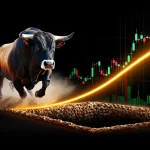US Stock Market Crash Date: Experts Talk, Now Let’s Take Action!
May 7, 2024
A Historical Perspective and the Futility of Crash Date Predictions
The stock market has long fascinated and frustrated investors, with its booms and busts shaping economic landscapes and individual fortunes. Despite the allure of predicting the next big crash, a look back at history reveals the impracticality of crash date predictions. This essay explores the limitations of such forecasts and offers a well-rounded perspective on market dynamics, drawing on insights from mass psychology and technical analysis.
The Dow Jones Industrial Average, a benchmark for the US stock market, provides a telling case study. In July 2019, its movements prompted discussions of a potential “triple top” pattern, indicating a possible upward trend reversal. However, a closer examination revealed the presence of extreme resistance and support zones, highlighting the index’s inflexion point. This example underscores the challenge of predicting precise turning points, as unpredictable factors influence market behaviour.
“It is easy to make purchases when the situation seems calm. Still, when it becomes challenging, many individuals tend to panic and retreat rather than embrace the potential opportunities that arise.”
Mass Psychology: Understanding Crowd Behavior
Instead of fixating on a stock market crash date, investors would be wiser to focus on the underlying trends and market sentiment. This essay will discuss how mass psychology and technical analysis can help investors make more informed decisions, ultimately rendering the concept of crashes moot
Mass psychology plays a pivotal role in market dynamics, and understanding crowd behaviour can provide valuable insights for investors. French philosopher Montaigne and social psychologist Gustav Le Bon offer thought-provoking perspectives.
In his essays, Montaigne delves into the complexities of human behaviour, arguing that individuals are often driven by their emotions and impulses rather than rational thought. He believed that people are prone to following the herd, especially in times of uncertainty, which can lead to irrational decisions. This idea resonates in the stock market, where investor sentiment can shift rapidly from greed to fear, driving market volatility.
Gustav Le Bon, a mass psychology pioneer, built upon these ideas. He suggested that individuals acting as part of a crowd lose their sense of personal responsibility and are easily influenced by those around them. This “lemming effect” is evident in market bubbles and crashes, where investors follow the herd, often to their detriment. Recognizing and understanding these behavioural patterns can help investors make more rational decisions and avoid being overwhelmed by the crowd’s emotions.
Technical Analysis: Identifying Trends and Support/Resistance Zones
Technical analysis provides a complementary approach to mass psychology, offering a quantitative framework for understanding market behaviour. By analysing past price movements and patterns, investors can identify trends and key support and resistance zones.
Support zones act as a floor for the market, indicating areas where buying pressure is likely to overcome selling pressure. Conversely, resistance zones represent price levels where selling pressure tends to dominate. Identifying these zones can help investors make more informed entry and exit decisions.
For example, consider the Dow’s movement 2019, as mentioned earlier. The index’s struggle to sustain itself above the 26,800-27,000 range for an extended period signalled strong resistance. A break above this zone could turn it into a solid support level, indicating a potential shift in the market trend. Technical analysis provides a toolkit for recognizing and acting on these critical inflexion points.
The Power of Combining Mass Psychology and Technical Analysis
By combining mass psychology and technical analysis, investors can enhance their ability to time the market effectively. Mass psychology helps identify crowd behaviour and market sentiment, while technical analysis provides a structured approach to identifying trends and critical price levels.
This combination enables investors to recognize when market sentiment reaches extremes, such as excessive greed or fear. Investors can make more timely and profitable decisions by aligning these sentiment extremes with technical indicators. For example, identifying a market top through crowd euphoria, confirmed by technical indicators, could prompt investors to exit their positions or even short the market.
Similarly, when fear and panic prevail during market crashes, mass psychology can help identify when sentiment is most harmful. The technical analysis then provides the framework to identify potential reversal zones, signalling attractive buying opportunities.
The Concept of Crashes: Are They Really Moot?
The argument that mass psychology and technical analysis can render the concept of crashes moot is compelling. By understanding crowd behaviour and utilizing technical tools, investors can better time their entries and exits, potentially avoiding the brunt of a market crash.
However, it is essential to acknowledge that even the most astute investors cannot always predict or control market movements. Crashes can be triggered by unforeseen events or systemic risks that rapidly spiral out of control. In such cases, the impact on investor sentiment and market trends can be swift and severe, leaving little time for reaction.
Additionally, it is worth considering that not all investors have the same risk appetite or access to information. While some may successfully navigate market downturns, others may be caught off guard and experience significant losses. Therefore, while crashes may be mitigated through careful analysis and timing, they cannot be entirely dismissed.
Final Thoughts: A Well-Rounded Perspective
As of July 2023, the stock market landscape continues to evolve, presenting new challenges and opportunities for investors. By learning from historical contexts, including our past statements, we gain insight into the futility of crash date predictions.
Instead of fixating on specific dates, investors should focus on understanding market trends, crowd behaviour, and technical indicators. This essay has discussed how mass psychology and technical analysis can help investors get out at the top and in at the bottom, improving their overall investment outcomes.
In conclusion, while experts may discuss and predict market crashes, the action lies in recognizing and utilizing the tools and insights presented in this essay. By embracing a well-rounded perspective, investors can make more informed decisions and navigate the ever-changing stock market more confidently and successfully.











